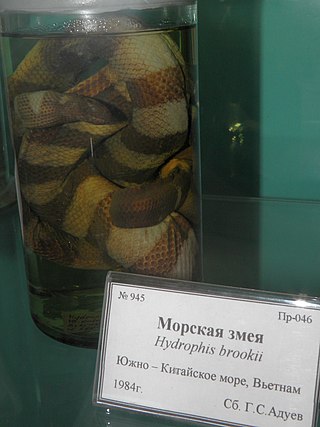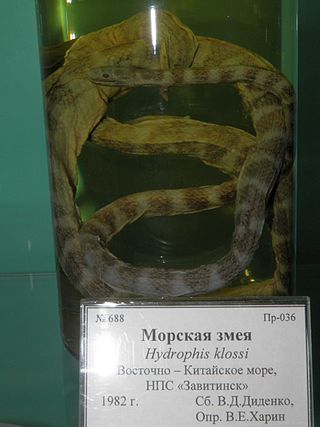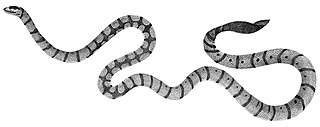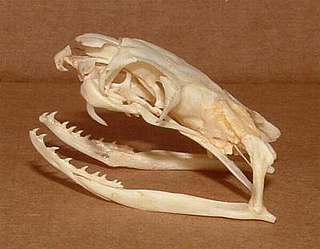
Elapidae is a family of snakes characterized by their permanently erect fangs at the front of the mouth. Most elapids are venomous, with the exception of the genus Emydocephalus. Many members of this family exhibit a threat display of rearing upwards while spreading out a neck flap. Elapids are endemic to tropical and subtropical regions around the world, with terrestrial forms in Asia, Australia, Africa, and the Americas and marine forms in the Pacific and Indian Oceans. Members of the family have a wide range of sizes, from the 18 cm (7.1 in) white-lipped snake to the 5.85 m king cobra. Most species have neurotoxic venom that is channeled by their hollow fangs, and some may contain other toxic components in various proportions. The family includes 55 genera with around 360 species and over 170 subspecies.

Stokes's sea snake is a large species of sea snake in the family Elapidae. It is sometimes placed in its own genus Astrotia. The species is endemic to tropical Indo-Pacific oceanic waters.

Hydrophis schistosus, commonly known as the beaked sea snake, hook-nosed sea snake, common sea snake, or the Valakadeyan sea snake, is a highly venomous species of sea snake common throughout the tropical Indo-Pacific. This species is implicated in more than 50% of all bites caused by sea snakes, as well as the majority of envenomings and fatalities.

Hydrophis belcheri, commonly known as the faint-banded sea snake or Belcher's sea snake, is an extremely venomous species of elapid sea snake. It has a timid temperament and would normally have to be subjected to severe mistreatment before biting. Usually those bitten are fishermen handling nets, although only one-quarter of those bitten are envenomated since the snake rarely injects much of its venom. Although not much is known about the venom of this species, its LD50 toxicity in mice has been determined to be 0.24 mg/kg when delivered intramuscularly.

Hydrophis brookii is a species of venomous sea snake in the subfamily Hydrophiinae of the family Elapidae. The species is native to bodies of water in Southeast Asia.

Hydrophis klossi, commonly known as Kloss's sea snake, is a species of sea snake in the family Elapidae. Like all other sea snakes, it is venomous. The species is endemic to the Indian Ocean.
Hydrophis lapemoides is a species of snake in the family Elapidae known commonly as the Persian Gulf sea snake. This sea snake is native to the Indian Ocean from the Persian Gulf to the coasts of Thailand.
Hydrophis mamillaris, sometimes referred to as the Bombay sea snake or broad-banded sea snake is a species of venomous sea snake native to the Indian Ocean. It is a poorly studied and surveyed species, with few records and a dubious type specimen.

Hydrophis spiralis, commonly known as the yellow sea snake, is a species of venomous sea snake in the family Elapidae.

Hydrophis curtus, also known as Shaw's Sea Snake, short sea snake, but often includes Hydrophis hardwickii is a species of sea snake. Like most Hydrophiinae sea snakes, it is a viviparous, fully marine, and front fanged elapid that is highly venomous. It is collected for a variety of purposes including human and animal food, for medicinal purposes and for their skin.

Microcephalophis gracilis, also known as the graceful small-headed seasnake, slender sea snake, narrow-headed sea snake, common small-headed sea snake, is a species of sea snake found in the Indian and Pacific Oceans. It is venomous.
Hydrophis viperinus, commonly known as the viperine sea snake, is a species of venomous sea snake in the family Elapidae (Hydrophiinae).

Venomous snakes are species of the suborder Serpentes that are capable of producing venom, which they use for killing prey, for defense, and to assist with digestion of their prey. The venom is typically delivered by injection using hollow or grooved fangs, although some venomous snakes lack well-developed fangs. Common venomous snakes include the families Elapidae, Viperidae, Atractaspididae, and some of the Colubridae. The toxicity of venom is mainly indicated by murine LD50, while multiple factors are considered to judge the potential danger to humans. Other important factors for risk assessment include the likelihood that a snake will bite, the quantity of venom delivered with the bite, the efficiency of the delivery mechanism, and the location of a bite on the body of the victim. Snake venom may have both neurotoxic and hemotoxic properties. There are about 600 venomous snake species in the world.

Sea snakes, or coral reef snakes, are elapid snakes that inhabit marine environments for most or all of their lives. They belong to two subfamilies, Hydrophiinae and Laticaudinae. Hydrophiinae also includes Australasian terrestrial snakes, whereas Laticaudinae only includes the sea kraits (Laticauda), of which three species are found exclusively in freshwater. If these three freshwater species are excluded, there are 69 species of sea snakes divided between seven genera.

Hydrophis is a genus of sea snakes, venomous snakes in the subfamily Hydrophiinae of the family Elapidae. Species in the genus Hydrophis are typically found in Indo-Australian and Southeast Asian waters. Currently, around 36 species are recognized as being valid.

Hydrophis peronii, commonly known as the horned sea snake, Peron's sea snake, and the spiny-headed seasnake, is a species of venomous snake in the subfamily Hydrophiinae of the family Elapidae. The species is endemic to the western tropical Pacific Ocean. It is the only sea snake with spines on the head. It is sometimes placed in its own genus Acalyptophis.

The yellow-bellied sea snake is a venomous species of snake from the subfamily Hydrophiinae found in tropical oceanic waters around the world except for the Atlantic Ocean. For many years, it was placed in the monotypic genus Pelamis, but recent molecular evidence indicates it lies within the genus Hydrophis.
Hydrophis zweifeli is a species of snakes found from New Guinea to Australia. In the past they were thought to be Enhydrina schistosa, but after DNA testing are now provisionally identified as Hydrophis zweifeli. DNA test have shown they are not related to Hydrophis schistosus.
Aipysurus mosaicus is a species of snake found in coastal seas of Australia. It is commonly known as the mosaic sea snake.












